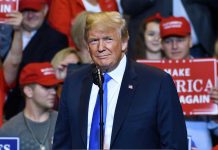
Donald Trump’s bold declaration to fire federal employees who don’t return to the office sparks controversy and debate over remote work policies.
At a Glance
- Trump vows to dismiss federal employees who don’t return to in-office work
- He plans to challenge Biden administration’s telework agreement
- Trump’s proposed Department of Government Efficiency aims to cut $2 trillion from federal budget
- Nearly half of federal workforce eligible for at least part-time remote work
- Implementing the proposal could result in over 1 million federal employees being fired
Trump’s Stance on Federal Employee Work Policies
In a move that has stirred up controversy, former President Donald Trump has taken a firm stance on federal employee work policies, threatening to fire those who do not return to in-office work. This declaration comes as the nation continues to grapple with evolving work practices shaped by the pandemic era.
Trump’s position directly challenges a recent telework agreement implemented by the Biden administration, which he criticizes as a “gift to a union.” The former president has made it clear that he intends to take legal action to stop this agreement, signaling a shift in federal employment policies with his return to office. “If people don’t come back to work, come back into the office, they’re going to be dismissed.” Trump stated.
President-elect Donald Trump said federal workers who don't want to work in the office will be fired, despite a union deal to allow federal workers to continue to telework into 2029. https://t.co/HIAhouEi77
— CBS News (@CBSNews) December 17, 2024
The Department of Government Efficiency
Central to Trump’s plan is the proposed Department of Government Efficiency, to be led by Elon Musk and Vivek Ramaswamy. This department aims to slash $2 trillion from the federal budget and closely examine work-from-home policies. Musk and Ramaswamy argue that requiring federal employees to work in-office could lead to voluntary terminations, which they view as a positive outcome. “Requiring federal employees to come to the office five days a week would result in a wave of voluntary terminations that we welcome: If federal employees don’t want to show up, American taxpayers shouldn’t pay them for the Covid-era privilege of staying home.”
Impact on Federal Workforce
The federal government currently employs over 4 million people, with a significant portion eligible for telework. According to an Office of Management and Budget report, approximately 1.1 million federal employees are eligible for part-time remote work, with an additional 280,000 in fully remote positions. Implementing Trump’s proposal could potentially result in over 1 million federal employees being fired if they do not comply with a five-day in-office requirement.
Critics argue that such a drastic change could lead to significant brain drain and negatively impact government operations. The move also raises questions about the efficacy of remote work and how government departments can balance productivity with modern workforce needs.
Broader Policy Implications
Beyond the issue of remote work, Trump’s plans extend to other areas of government policy. He has expressed intentions to roll back environmental regulations for businesses investing $1 billion or more in the U.S., offering expedited permits and approvals. This aligns with his commitment to “unleash American energy” and promises quick approvals for energy infrastructure projects.
As the debate over federal work policies continues, it’s clear that the outcome will have far-reaching implications for government operations, employee satisfaction, and the broader landscape of American work culture. The potential for significant changes in federal employment practices underscores the importance of this issue in the upcoming election cycle.
Sources:
Trump Vows to Fire Federal Workers Who Don’t Come to Office
Trump says federal workers who don’t want to return to the office are “going to be dismissed”
Trump: Feds will be ‘dismissed’ if they don’t go to office
Donald Trump Says Federal Employees Who Don’t Work in the Office Will Be Fired













